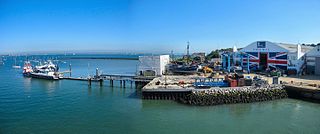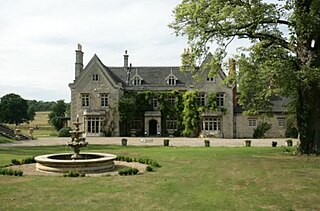
Ventnor is a seaside resort town and civil parish established in the Victorian era on the southeast coast of the Isle of Wight, England, eleven miles (18 km) from Newport. It is situated south of St Boniface Down, and built on steep slopes leading down to the sea. The higher part is referred to as Upper Ventnor ; the lower part, where most amenities are located, is known as Ventnor. Ventnor is sometimes taken to include the nearby and older settlements of St Lawrence and Bonchurch, which are covered by its town council. The population is 5,567 according to the 2021 Census

East Cowes is a town and civil parish in the north of the Isle of Wight, on the east bank of the River Medina, next to its west bank neighbour Cowes. It has a population of 8,428 according to the 2021 Census.

St Lawrence is a village and former civil parish, now in the parish of Ventnor, on the south coast of the Isle of Wight, in southern England. It is located to the west of the town of Ventnor, in the Undercliff, which is subject to landslips. The Undercliff lies between the original high cliff and the sea, formed over thousands of years, since the last Ice Age, from accumulated landslips. Several rocky coves can be accessed from the coastal path, which affords fine views of some prominent Victorian villas, set in a wooded landscape below the great rock wall of the original sea cliff: Woody Bay, Mount Bay and Orchard Bay. The area of the parish was around 329 acres (133 ha) in size. In 1931 the parish had a population of 329. On 1 April 1933 the parish was abolished and merged with Ventnor.

Ventnor Botanic Garden is a botanic garden located in Ventnor, Isle of Wight. It was founded in 1970, by Sir Harold Hillier, and donated to the Isle of Wight Council.

Norris Castle is located on the Isle of Wight. It was designed by James Wyatt for Lord Henry Seymour. The estate adjoins Osborne House, country home to Queen Victoria. On the other side of Norris Castle sits the Spring Hill estate, bought by William Goodrich in 1794. Norris Castle was built in 1799 and sits in 225 acres of land, with a mile of waterfront. The Castle is a Grade I listed building.

East Cowes Castle, located in East Cowes, was the home of architect John Nash between its completion and his death in 1835. Nash himself was the designer of the site, and began construction as early as 1798. It was completed in 1800 and was said to have been built at unlimited expense. Nash was finally interred in the grounds.
The Ardlamont Murder, which took place in Argyll, Scotland, on 10 August 1893, gave rise to two high-profile court cases: a murder trial in Edinburgh, and a defamation trial in London the following year.
Hans Stanley, PC was a British diplomat and politician who sat in the House of Commons between 1743 and 1780.

Ventnor West railway station was in operation from 1900 to 1952 in Ventnor, Isle of Wight.
Puckaster is a hamlet on the Isle of Wight, England. Puckaster is on the southern coast of the Isle of Wight, south of Niton, between St Catherine's Point and Binnel.

St Catherine's, Ventnor is a parish church in the Church of England located in Ventnor, Isle of Wight.

Orchard Bay is a sandy bay and shingle beach on the south-east coast of the Isle of Wight, England. It lies to the south-west of the Ventnor Botanic Garden and just along the coast west from Steephill Cove. It faces south towards the English Channel, its shoreline is 220 yards (200 m) in length - 65 yards (60 m) of which is beach.
John Morgan Richards, was an American businessman and entrepreneur who made his fortune from the promotion of patent medicines and American cigarettes in Britain. He was the father of the novelist Pearl Mary Teresa Craigie.

Pearl Mary Teresa Richards was an Anglo-American novelist and dramatist who wrote under the pen-name of John Oliver Hobbes. Though her work fell out of print in the twentieth century, her first book Some Emotions and a Moral was a sensation in its day, selling eighty thousand copies in only a few weeks.
Steephill Manor is a British manor house on the Isle of Wight, situated within the Newchurch parish.
The Undercliff, Isle of Wight, England is a tract of semi-rural land, around 5 miles (8.0 km) long by 0.25–0.5 miles (0.40–0.80 km) wide, skirting the southern coast of the island from Niton to Bonchurch. Named after its position below the escarpment that backs this coastal section, its undulating terrain comprises a mix of rough pasture, secondary woodland, parkland, grounds of large isolated houses, and suburban development. Its sheltered south-facing location gives rise to a microclimate considerably warmer than elsewhere on the island. Although inhabited, the Undercliff is an area prone to landslips and subsidence, with accompanying loss of property over time. Settlements along the Undercliff, from west to east, are: lower Niton, Puckaster, St Lawrence, Steephill, the town of Ventnor, and Bonchurch.
John Arthur Fyler was an English politician, Conservative Member of Parliament 1903–04 for the English constituency of Chertsey.

Pipewell Hall in Northamptonshire, England, is a building of historical significance and is Grade II listed on the English Heritage Register. It was built near the ruins of a Cistercian abbey in 1675. At this time it was owned by the Barons of Powis. The house was constructed from the stones of the abbey. The Hall was the home of many notable people over the next three centuries and is now a wedding venue.











